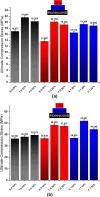Layer combination of similar infill patterns on the tensile and compression behavior of 3D printed PLA
- PMID: 40189629
- PMCID: PMC11973139
- DOI: 10.1038/s41598-025-94446-8
Layer combination of similar infill patterns on the tensile and compression behavior of 3D printed PLA
Abstract
With the growing popularity of 3D-printed products, material consumption has been a major concern in additive manufacturing in recent years. Choosing the infill structure and the printing parameters for an application can be challenging for product designers and engineers, which can lead to reduced material and increased cost savings while maintaining product functioning.This study investigates the mechanical behavior of 3D-printed PLA structures by exploring the influence of multi-layer infill patterns on tensile and compressive strength. Three common infill patterns (triangular, grid, and honeycomb) were evaluated at 20% and 50% densities. A novel approach was employed, incorporating specimens with single-, two-, and four-layer same pattern combinations, where subsequent layers were rotated 180 degrees to enhance interlayer bonding. Results demonstrated significant improvements in both tensile (up to 64%) and compressive strength (up to 47%) for two-layer structures compared to single-layer counterparts. The findings provide valuable insights into optimizing infill design and layer configurations for improved tensile and compressive strength and material efficiency in 3D-printed structures. This research highlights the potential for optimizing 3D-printed part performance through strategic multi-layer infill design, offering a pathway toward reduced material consumption and enhanced mechanical properties in additive manufacturing.
Keywords: 3D-printing; Additive manufacturing; Combined infill patterns; Fused deposition modeling (FDM); Infill structure; Polylactic acid; Polymer.
© 2025. The Author(s).
Conflict of interest statement
Declarations. Competing interests: The authors declare no competing interests.
Figures














Similar articles
-
Analysis of the Impact of Cooling Lubricants on the Tensile Properties of FDM 3D Printed PLA and PLA+CF Materials.Polymers (Basel). 2024 Aug 5;16(15):2228. doi: 10.3390/polym16152228. Polymers (Basel). 2024. PMID: 39125254 Free PMC article.
-
The Effects of Combined Infill Patterns on Mechanical Properties in FDM Process.Polymers (Basel). 2020 Nov 26;12(12):2792. doi: 10.3390/polym12122792. Polymers (Basel). 2020. PMID: 33255897 Free PMC article.
-
Experimental Study of the Tensile Behavior of Structures Obtained by FDM 3D Printing Process.Polymers (Basel). 2024 May 31;16(11):1562. doi: 10.3390/polym16111562. Polymers (Basel). 2024. PMID: 38891508 Free PMC article.
-
Optimisation of Strength Properties of FDM Printed Parts-A Critical Review.Polymers (Basel). 2021 May 14;13(10):1587. doi: 10.3390/polym13101587. Polymers (Basel). 2021. PMID: 34069144 Free PMC article. Review.
-
FDM-Based 3D Printing of Polymer and Associated Composite: A Review on Mechanical Properties, Defects and Treatments.Polymers (Basel). 2020 Jul 10;12(7):1529. doi: 10.3390/polym12071529. Polymers (Basel). 2020. PMID: 32664374 Free PMC article. Review.
References
-
- Wang, B. The future of manufacturing: A new perspective. Engineering4 (5), 722–728. 10.1016/j.eng.2018.07.020 (2018).
-
- Zivanovic, S. T., Popovic, M. D., Vorkapic, N. M., Pjevic, M. D. & Slavkovic, N. R. An overview of rapid prototyping technologies using subtractive, additive and formative processes. FME Trans.48 (1), 246–253. 10.5937/FMET2001246Z (2020).
-
- Jiménez, M., Romero, L., Domínguez, I. A., Espinosa, M. D. M. & Domínguez, M. Additive manufacturing technologies: an overview about 3D printing methods and future prospects. Complexity2019 (1), 9656938. 10.1155/2019/9656938 (Jan. 2019).
-
- Cano-Vicent, A. et al. Fused deposition modeling: current status, methodology, applications, and future prospects. Addit. Manuf.47, 102378. 10.1016/J.ADDMA.2021.102378 (Nov. 2021).
LinkOut - more resources
Full Text Sources

